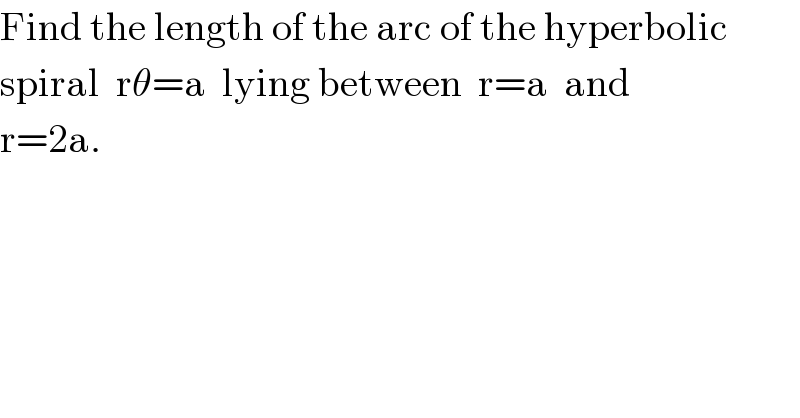
Question Number 11413 by agni5 last updated on 24/Mar/17

$$\mathrm{Find}\:\mathrm{the}\:\mathrm{length}\:\mathrm{of}\:\mathrm{the}\:\mathrm{arc}\:\mathrm{of}\:\mathrm{the}\:\mathrm{hyperbolic} \\ $$$$\mathrm{spiral}\:\:\mathrm{r}\theta=\mathrm{a}\:\:\mathrm{lying}\:\mathrm{between}\:\:\mathrm{r}=\mathrm{a}\:\:\mathrm{and}\: \\ $$$$\mathrm{r}=\mathrm{2a}. \\ $$
Answered by mrW1 last updated on 26/Mar/17
![r=(a/θ) (dr/dθ)=−(a/θ^2 ) (√(r^2 +((dr/dθ))^2 ))=((a(√(1+θ^2 )))/θ^2 ) L=∫_θ_1 ^θ_2 (√(r^2 +((dr/dθ))^2 ))dθ=a∫_θ_1 ^θ_2 ((√(1+θ^2 ))/θ^2 )dθ =a[−((√(1+θ^2 ))/θ)+ln (θ+(√(1+θ^2 )))]_θ_1 ^θ_2 =a[((√(1+θ_1 ^2 ))/θ_1 )−((√(1+θ_2 ^2 ))/θ_2 )+ln ((θ_2 +(√(1+θ_2 ^2 )))/(θ_1 +(√(1+θ_1 ^2 ))))] with θ_1 =(a/r_1 )=(a/(2a))=(1/2) and θ_2 =(a/r_2 )=(a/a)=1 L=a[((√(1+(1/4)))/(1/2))−((√(1+1))/1)+ln ((1+(√(1+1)))/((1/2)+(√(1+(1/4)))))] L=a[(√5)−(√2)+ln ((2(1+(√2)))/(1+(√5)))]](Q11414.png)
$${r}=\frac{{a}}{\theta} \\ $$$$\frac{{dr}}{{d}\theta}=−\frac{{a}}{\theta^{\mathrm{2}} } \\ $$$$\sqrt{{r}^{\mathrm{2}} +\left(\frac{{dr}}{{d}\theta}\right)^{\mathrm{2}} }=\frac{{a}\sqrt{\mathrm{1}+\theta^{\mathrm{2}} }}{\theta^{\mathrm{2}} } \\ $$$${L}=\int_{\theta_{\mathrm{1}} } ^{\theta_{\mathrm{2}} } \sqrt{{r}^{\mathrm{2}} +\left(\frac{{dr}}{{d}\theta}\right)^{\mathrm{2}} }{d}\theta={a}\int_{\theta_{\mathrm{1}} } ^{\theta_{\mathrm{2}} } \frac{\sqrt{\mathrm{1}+\theta^{\mathrm{2}} }}{\theta^{\mathrm{2}} }{d}\theta \\ $$$$={a}\left[−\frac{\sqrt{\mathrm{1}+\theta^{\mathrm{2}} }}{\theta}+\mathrm{ln}\:\left(\theta+\sqrt{\mathrm{1}+\theta^{\mathrm{2}} }\right)\right]_{\theta_{\mathrm{1}} } ^{\theta_{\mathrm{2}} } \\ $$$$={a}\left[\frac{\sqrt{\mathrm{1}+\theta_{\mathrm{1}} ^{\mathrm{2}} }}{\theta_{\mathrm{1}} }−\frac{\sqrt{\mathrm{1}+\theta_{\mathrm{2}} ^{\mathrm{2}} }}{\theta_{\mathrm{2}} }+\mathrm{ln}\:\frac{\theta_{\mathrm{2}} +\sqrt{\mathrm{1}+\theta_{\mathrm{2}} ^{\mathrm{2}} }}{\theta_{\mathrm{1}} +\sqrt{\mathrm{1}+\theta_{\mathrm{1}} ^{\mathrm{2}} }}\right] \\ $$$$ \\ $$$${with}\:\theta_{\mathrm{1}} =\frac{{a}}{{r}_{\mathrm{1}} }=\frac{{a}}{\mathrm{2}{a}}=\frac{\mathrm{1}}{\mathrm{2}}\:{and}\:\theta_{\mathrm{2}} =\frac{{a}}{{r}_{\mathrm{2}} }=\frac{{a}}{{a}}=\mathrm{1} \\ $$$${L}={a}\left[\frac{\sqrt{\mathrm{1}+\frac{\mathrm{1}}{\mathrm{4}}}}{\frac{\mathrm{1}}{\mathrm{2}}}−\frac{\sqrt{\mathrm{1}+\mathrm{1}}}{\mathrm{1}}+\mathrm{ln}\:\frac{\mathrm{1}+\sqrt{\mathrm{1}+\mathrm{1}}}{\frac{\mathrm{1}}{\mathrm{2}}+\sqrt{\mathrm{1}+\frac{\mathrm{1}}{\mathrm{4}}}}\right] \\ $$$${L}={a}\left[\sqrt{\mathrm{5}}−\sqrt{\mathrm{2}}+\mathrm{ln}\:\frac{\mathrm{2}\left(\mathrm{1}+\sqrt{\mathrm{2}}\right)}{\mathrm{1}+\sqrt{\mathrm{5}}}\right] \\ $$
Commented by mrW1 last updated on 26/Mar/17

$${the}\:{answer}\:{is}\:{corrected}. \\ $$$${please}\:{see}\:{also}\:{Q}\mathrm{11433}. \\ $$
